I am taking a class that deals much with German history and life, and I have learned so much that I feel like my brain is going to burst with new information...and happiness at learning it!
I wrote earlier about being really surprised during a cooking class when the instructor said that she just uses any tablespoon or teaspoon she has on hand when it's called for. Before I got here, I didn't realize that Europeans often use a scale when preparing food from a recipe. Germans also would use a regular cup from the cupboard and not a specific measuring cup, I learned from the comments on what I wrote.
Imagine how delighted I was when I learned more about this from the instructor teaching a class I'm taking on life in German and its history. Seriously, yeah, it's nerdy, but the whole thing made me very curious so it was great to satisfy that curiosity.
Here are the interesting things that I learned from the instructor:
There have been many units of measurement used over time, but they have been highly variable because they were often based on something that could vary greatly. That doesn't work so well when, for example, the length of a "foot" was based on someone's foot, thanks to the curiosity of differing genetics. Merchants selling bolts of cloth were happy when they sold a short arm's length for the going rate but when they came someone with long arms using the arms as measurement, they found themselves being shorted.
Another interesting thing is the size of cups and bowls. Usually a town had the same person (or group) making pottery, often for the life of that person. The depth of the cup would be dependent upon the length of the thumb of the person throwing the pottery. Therefore, for the career of the person, the cups would be approximately the same depth. The problem arose when the next person took over as his thumb would be a different length.
Napoleon, after conquering much of Europe, had the idea that standardized measurements were in order. It helped regulate trade. Of course, it was a slow process to try to force what had been hundreds of kingdoms, many with their own measurements, to adopt standard measurements. Chancellor Otto von Bismarck found himself enforcing the last of standardization 50-60 years after Napoleon's decision.
All of this ties into the questions I had about German cooking. Why is it that Germans would just take a cup out of the cupboard in recipes that say to measure a cup of thing? Why are those recipes not specific? After all, cups are all of such varying sizes! My instructor says it's simple: many of the recipes or cookbooks had been in use in the family for so long that everyone knew the correct amount of ingredients to put in, and they would use the same cup to measure things. With experience on her side, the cook or baker had a feel for what was the correct amount. I'm floored by this, mostly because my domestic skills are very much wanting, but I'm impressed, nonetheless.

No comments:
Post a Comment